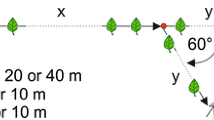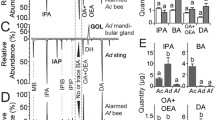Abstract
Social insects have evolved highly developed communication systems, enabling them to coordinate complex interactions in their colonies. Pheromones play a major role in the coordination of many tasks. In Trigona corvina, a stingless bee that occurs in Central America, foragers use pheromones produced in their labial glands to scent mark solid substrates between a food source and their nest. Newly recruited bees subsequently follow these scent marks until they reach the food source. A recent study has revealed nest-specific differences in the composition of these trail pheromones in colonies of T. corvina, suggesting that pheromone specificity may serve to avoid competition between foragers from different nests. However, the nests used in this study came from different populations and their foragers certainly never met in the field (Jarau et al., 2010). The aim of the present study was to investigate whether differences in the trail pheromones of foragers from different nests can also be found between neighbouring colonies within populations. We analysed the composition of trail pheromones from labial gland secretions extracted from workers from nine colonies collected at three different populations in Costa Rica. The differences in pheromone composition were even more distinct between neighbouring nests within a population than between nests of different populations. This finding corroborates the hypothesis that nest specificity of trail pheromones serves to communicate the location of a food source exclusively to nestmates, thereby avoiding intraspecific competition at resources. Resource partitioning by avoiding conspecific non-nestmates is particularly adaptive for aggressive bee species, such as T. corvina.


Similar content being viewed by others
References
Aguilar I., Fonseca A. and Biesmeijer J.C. 2005. Recruitment and communication of food source location in three species of stingless bees (Hymenoptera, Apidae, Meliponini). Apidologie 36: 313-324
Araújo E.D., Costa M., Chaud-Netto J. and Fowler H.G. 2004. Body size and flight distance in stingless bees (Hymenoptera: Meliponini): inference of flight range and possible ecological implications. Braz. J. Biol. 64: 563-568
Biesmeijer J.C. and Slaa E.J. 2004. Information flow and organization of stingless bee foraging. Apidologie 35: 143-157
Blum M.S. and Brand J.M. 1972. Social insect pheromones: their chemistry and function. Am. Zool. 12: 553-576
Chapman R.F. 1998. The Insects: Structure and Function. 4th ed. Cambridge University Press, Cambridge
Field A. 2009. Discovering Statistics using SPSS. 3rd ed. SAGE Publication Ltd. London
Jarau S., Hrncir M., Zucchi R. and Barth F.G. 2004. A stingless bee uses labial gland secretions for scent trail communication (Trigona recursa Smith 1863). J. Comp. Physiol. A 190: 233-239
Jarau S., Schulz C.M., Hrncir M., Francke W., Zucchi R., Barth F.G. and Ayasse M. 2006. Hexyl decanoate, the first trail pheromone compound identified in a stingless bee, Trigona recursa. J. Chem. Ecol. 32: 1555-1564
Jarau S., Dambacher J., Twele R., Aguilar I., Francke W. and Ayasse M. 2010. The trail pheromone of a stingless bee, Trigona corvina (Hymenoptera, Apidae, Meliponini), varies between populations. Chem. Sens. 35: 593-601
Jarau S., Hemmeter K., Aguilar I. and Ayasse M. 2011. A scientific note on trail pheromone communication in a stingless bee, Scaptotrigona pectoralis (Hymenoptera, Apidae, Meliponini). Apidologie 42: 708-710
Johnson L.K. 1983. Foraging strategies and the structure of stingless bee communities in Costa Rica. In: Social Insects in the Tropics (Jaisson P., Ed), Presses de l’Université Paris XIII, Paris. pp 31-58
Johnson L.K. and Hubbell S.P. 1974. Aggression and competition among stingless bees: Field studies. Ecology 55: 120-127
Lichtenberg E.M., Hrncir M., Turatti I.C. and Nieh J.C. 2011. Olfactory eavesdropping between two competing stingless bee species. Behav. Ecol. Sociobiol. 65: 763-774
Michener C.D. 2000. The Bees of the World. Johns Hopkins University Press, Baltimore London
Sakagami S.F. 1982. Stingless bees. In: Social Insects, Vol. III (Hermann H.R., Ed.), Academic Press, New York. pp 361-423
Schorkopf D.L.P., Jarau S., Francke W., Twele R., Zucchi R., Hrncir M., Schmidt V.M., Ayasse M. and Barth F.G. 2007. Spitting out information: Trigona bees deposit saliva to signal resource locations. Proc. R. Soc. B 274: 895-898
Slaa E.J. 2003. Foraging Ecology of Stingless Bees: From Individual Behaviour to Community Ecology. Dissertation thesis, Utrecht University
Stangler E.S., Jarau S., Hrncir M., Zucchi R. and Ayasse M. 2009. Identification of trail pheromone compounds from the labial glands of the stingless bee Geotrigona mombuca. Chemoecology 19: 13-19
Wille A. 1983. Biology of the stingless bees (Meliponinae, Apidae). Annu. Rev. Entomol. 28: 41-64
Wilson E.O. 1971. The Insect Societies. Belknap Press, Cambridge
Acknowledgments
Financial support for the field work of this study was provided by Deutscher Akademischer Austauschdienst.
Author information
Authors and Affiliations
Corresponding author
Rights and permissions
About this article
Cite this article
John, L., Aguilar, I., Ayasse, M. et al. Nest-specific composition of the trail pheromone of the stingless bee Trigona corvina within populations. Insect. Soc. 59, 527–532 (2012). https://doi.org/10.1007/s00040-012-0247-5
Received:
Revised:
Accepted:
Published:
Issue Date:
DOI: https://doi.org/10.1007/s00040-012-0247-5




